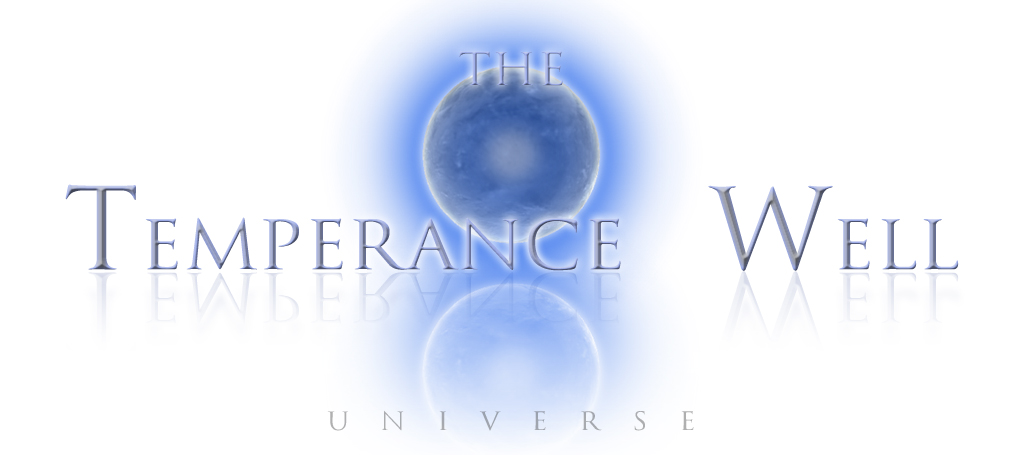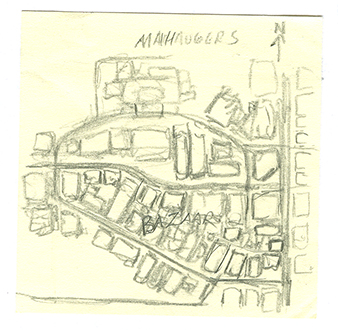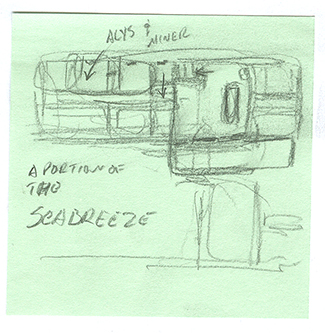Topic: Notes
An idea can be like a bush, it can grow so much foliage as to hide the trunk. Since the summer of 2008, I've idea upon idea, each one evolving toward something new, secondary characters becoming primary characters, new adventures replacing old ones, until it becomes so convoluted, it becomes a thick tangle difficult to navigate. It's time to break out the pruning shears, snip off some wild tangent branches, and get back to the core of the story.
The story . . . which is what?
The Temperance Well is about free will and theological determinism, and if the two are diametric or can be reconciled. The original idea had a godlike being that could travel through time as we travel through space, and having entered our dimensions froze time since the history of the universe was "his" past. The whole idea was that if someone from the distant future visited the distant past, then everything between those two events was certain to happen, if we make the premise that the past is immutable. It very may be, and this is the common sense on the matter, though there are some scientist that speculate that the past may be as chaotic as the future, in that if we were able to travel back in time, we would find events have played out not as we remembered.
To truly get a grasp of this, one has to consider a world-line, a physical interpretation of an object as it moves through space, like a pinhead leaving a trail of thread. In an universe with an immutable past, such world-lines are static and unmoving in the past, and wriggling about like worms in the future—if we assume that world-lines extend into the future, as they would in a predestined universe. In an universe with a chaotic past, the world-lines in both past and future wriggle about, which was the condition the old character Kha wanted—a condition that set up the stakes whereby such a state might create pasts where other intelligent species never came to be. That's one considered possibility of the true nature of the universe. But from our limited experience, the past has happened and the present is a temporal horizon in which the only paths to follow are ones that build the future; we cannot cross that horizon back into the past, and the future remains as nonexistent possibilities. That seems to be our intuitive experience with time.
But in a predestined universe, a person's whole life exists as this odd temporal world-line, from the merger of world-lines of ovum and sperm, to the unraveling world-lines of decomposition. But from birth to death, there is a four dimensional object that represents a person whose three dimensional shape is naught but a cross-section. If the world-line is not being built as the person move through time, then what is it exactly that moves along the world-line as the person experiences time?
And what is memory? Is memory what we experience when we turn out inner eye to peer down the world-line? If so, what prevents us from peering up the world-line into the future? Or do we? In a nonpredestined universe, perhaps with no set futures, our imaginations are linked to possible future outcomes. But in a predestined universe, should we not be able to "premember" the future? Or is the Present a temporal horizon we can’t see over? These are the questions that lace the concepts of this fictional universe. (As a side note, I believe that predestined or not, world-lines can oxbow or maybe intersect themselves. I'll leave you to contemplate what that means.)
And so the actual physical Temperance Well was going to be the result of the merger of the four Shards of the Wellstone, that mighty artifact built by an elder race from a prior universe made to draw together the two branes and thus create the Big Bang. And Kha's meddling in our affairs froze time and created a predestined universe . . . but I had no plans to make "him" the actual God. And if Kha's actions were like a being from the future visiting the past, then why not throw out the whole idea of Kha and the Shards and make the Temperance Well a physical object that actually has something to do with back-in-time travel? This solves a lot of bothersome problems.
Kha: a godlike being has the problem that its inhibitions and inabilities are purely by the hand of the author and do not arise naturally from the rules of the fictional universe. It would be difficult to craft such rules that in turn ruled out the godlike being. Kha, then should not exist.
The Last Shard itself is merely a McGuffin, a plot device the characters are after. In this case, the alien species Jautoc and Apaxan are made aware of Kha's goals through the Elders. Both conspire to hide the shard in the Earth so that Kha cannot get it—why can't he get it, because I said so. If Kha can pluck hearts out of chests without reaching into the body, he should be able to pluck out the Shard from the core of the Earth. But I decided that he couldn't do that on the weak premise the Elders made the Drawingstone that way. And so Kha needed humans to destroy the Earth to get at the Shard, but the Jautoc and the Apaxan knew that humans would be loath to destroy their own world, especially since the Apaxan dispersed them helter-skelter into the galaxy and no one lives there anymore, but O! the fond memories that have since evolved into humorous myths no one takes seriously. If you see the problem with that plot as I do, then you understand why the Shard has to go.
No more Kha, and no more Shard. And the hell with it, let's toss out the Jautoc too.
So, what becomes the Temperance Well now? It has to be physical thing . . . a construction . . . a powerful machine. And one not rooted in some hyperdimensional flight of fancy, but in real science speculation.
It has to be a time machine.
It has to be the very thing that has been created to invoke predestination.
It is based on the Tipler Cylinder, a hypothetical device (of infinite length) that once spun up to near light-speed will twist up spacetime near it as to allow time travel back to the time when it was first spun up to near light-speed. That the niggling thing about back-in-time travel, if you use a super dense spinning cylinder or a wormhole, you can't travel back to a time prior to the use of the device as a time machine. I first saw the cylinder on a Science Channel show about time travel, but the cylinder or tube they were speculating about was of finite length. I don't recall the specific length, but the diameter was six miles. My question of why six miles is what stuck in my head.
For most of the universe—or at least the time span of concern to humans—to be predetermined by a person or being from the remote future traveling to the past, the machine has to built and engaged in the remote past. This would be more likely a machine of the Elders. And the caveat is that the gravitational stresses are so severe that any spacecraft the humans or the apaxan were to use would be destroyed. That means a special vehicle must be used. It's this Elder vehicle that replaces the Shard. The vehicle can transverse the Temperance Well and return to the past. The assumption is that the cylinder was built, and the vehicle was sent out at incredible speed to invoke time dilation so that it traveled to the remote future rather swiftly from its points of view, and like molasses running uphill for the point of view of the rest of universe (although like a black hole, it would probably be hidden by an event horizon). But wait! It's two of them. Because the Temperance Well Universe operates in a predestined mode, it has completed its mission. As soon as the strange Elder craft leaves the Well, it emerges from the Well. The younger version of it moves off into the distant future, while the older version has the job of defending its younger self from those forces that plan to stop it. History is caught in a temporal causal loop, and someone (perhaps Raum, as I need a singular villain) plans to break it. Or maybe he wants to prevent it from being broken by those who think it should.
This change to the change to the change means no useless plot-hole destruction of the Earth's environment or the need for the apaxan to save us. In this revamp, we head out for the stars and the apaxan find us. I never liked making we humans the beneficiaries to apaxan altruism, even though it was a selfish ploy to hide the Shard. I think giving them an ulterior motive to manipulate us was a good idea, the premise it was based upon was flawed. Now the relationship is new territory.
The Mercator stories were shots in the dark. Talk about convolutions. There is too much going on, enough for a season or two of a one hour television series on The Cargile Network. The only thing those stories had to connect it to the Shard was that Raum would do something to make Kariden chase him into the time dilated future. Sad to say, its mostly back story, with even more past back story planned! I enjoyed writing the stories, but in the back of my mind I kept asking what it had to do with The Story. I still want things to happen on Mercator. I still want things to happen between Raum and Kariden. But do I need the Ravens? Do I need Raum to be a warlord? Perhaps not.
The new structure revamps "Signpost"—I did have larger plans for this whereby in the sequel "Unsouled", Kha cleverly recruits someone to thwart Kariden's endeavors during his pursuit of Raum—so that the Elder vehicle is discovered (which version?) on the Cross planetoid. Which leads to Raum's eventual arrival at Mercator.
Lots of changes, I know, but my goal is to whittle the story down to its essentials, get rid of unnecessary characters, maybe meld some together. Do I need Codus Cosundi? Or Wisty? Or even the Rector. There are lots of aspects for me to contemplate and consider.
But first there is this damned spaghetti western, which might actually have something to do with this Temperance Well thing after all. If not for this side track, I wouldn’t have found the means to do away with the Shard.
You might say it's predestination.



